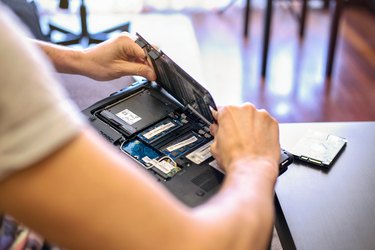
Few things can be as frustrating as a laptop with a battery that fails to provide a significant charge. While laptops can still be used while plugged into an outlet, having to constantly plug in can cause significant work interruptions, in addition to being a frequent frustration. Instead of buying an entirely new battery to solve the problem, however, you may be able to reset the laptop battery to provide a more consistent or accurate charge. While you may not be able to fix a dead laptop battery that refuses to charge at all, or a battery from an old laptop that hasn't been used in a few years, a battery reset can help extend the life of a battery that has been in use for some time – without too much extra work.
Bad Battery Troubles
Video of the Day
There are a variety of reasons why a battery might be providing less battery life to a laptop over time: significant changes in temperature can disrupt the battery's ability to function – particularly in laptops using lithium-ion batteries – and over time power cells can simply degrade with heavy use. Leaving your laptop on the charger while it's fully charged can decrease the amount of power the battery can hold as well. While some of these problems can be mitigated with regular laptop maintenance, like cleaning dust from fans, issues with the battery itself will require a direct approach. Resetting the battery causes the smart sensor in the battery to reconnect to the laptop itself, allowing for a more accurate power reading – and in certain systems, resetting will allow the laptop to fully interface with and make use of the battery by ensuring that it is fully compatible with the system.
Video of the Day
How to Reset a Laptop Battery
You can reset a laptop battery without any tools or specialized computer knowledge – all you need is time and patience. To begin, first allow your laptop's battery to drain completely: save any files or sensitive work as needed, as you'll need to let your laptop die. Once this occurs, close the laptop and flip it over to access the battery itself. Remove it using the tabs or buttons on the bottom of the laptop's casing. If your laptop battery has a dedicated "Reset" button, press it. If it does not, you will want to clean any dust or buildup from the connection points, then set the battery aside. Connect the laptop to its power cable and press the power button. If your laptop is capable of booting without the battery, allow it to boot completely, then shut it down via the OS menu. If your laptop requires an attached battery to boot, simply hold the power button down for 30 seconds. Reconnect the battery, then allow it to charge for one hour without powering on the laptop. After this hour, your battery should be reset – and upon booting your laptop, you should get a more accurate battery reading.
Calibrating Laptop Batteries
Once you've reset your laptop's battery, charge it to full and let the laptop run down to empty, to monitor the battery life. Once it's been fully charged again, you may wish to calibrate the battery and your laptop's power usage, in order to get more from a full charge. While this has often been done through the use of a battery calibration tool, in Windows 10 your laptop's power usage can be adjusted through the built-in "Battery Settings" menu. To access this, click the battery icon in the right corner of the taskbar, then click the "Battery Settings" option to access the menu. From here, you can adjust your laptop's settings to prioritize battery life, or – by turning off any battery saving settings, letting your laptop die, then charging it back up before enabling settings again – calibrate further for an even more accurate reading. Do note, however, that laptop PC battery calibration isn't an exact science, nor is it a perfect solution. Calibration may reveal that a battery has even less capacity than you'd thought, or may only be able to squeeze an additional 30 minutes to an hour of runtime out of a battery. If your laptop battery is genuinely failing, the best solution is still to replace the battery with a new one.
- Windows Central: How to Recalibrate the Battery in Your Windows 10 Laptop
- North Carolina Consumers Council: How To Reset a Dell Laptop Battery That's Not Being Detected and Not Charging
- Bright Hub: How to Reset Laptop Battery: Getting More From Your Laptop Battery
- How-To Geek: How to Calibrate Your Laptop’s Battery for Accurate Battery Life Estimates